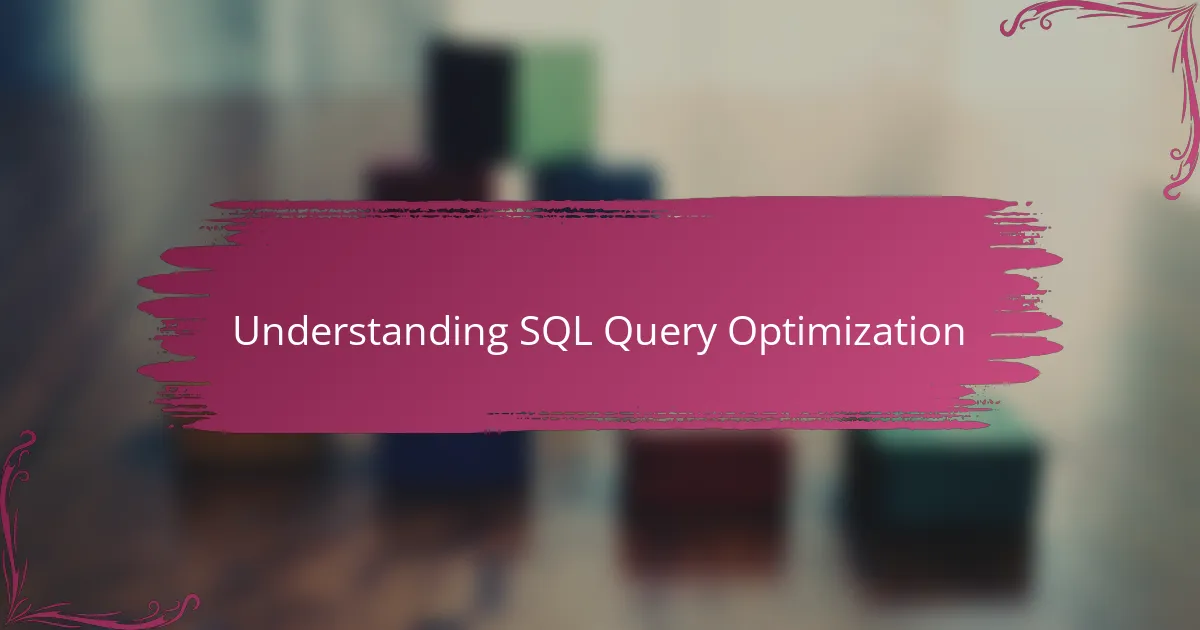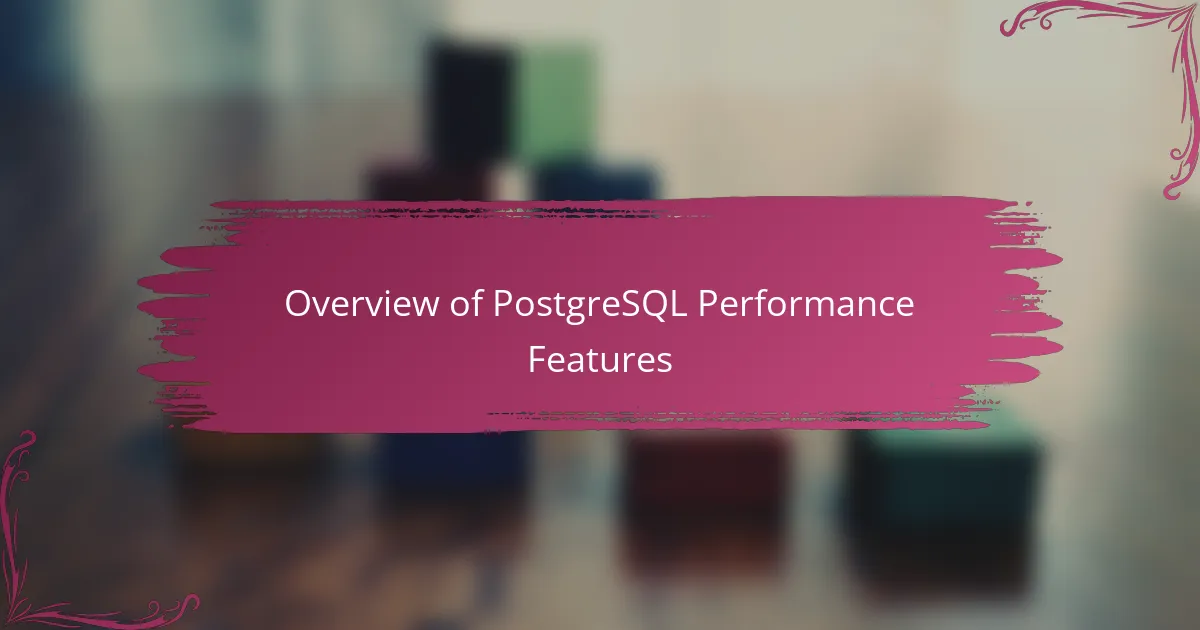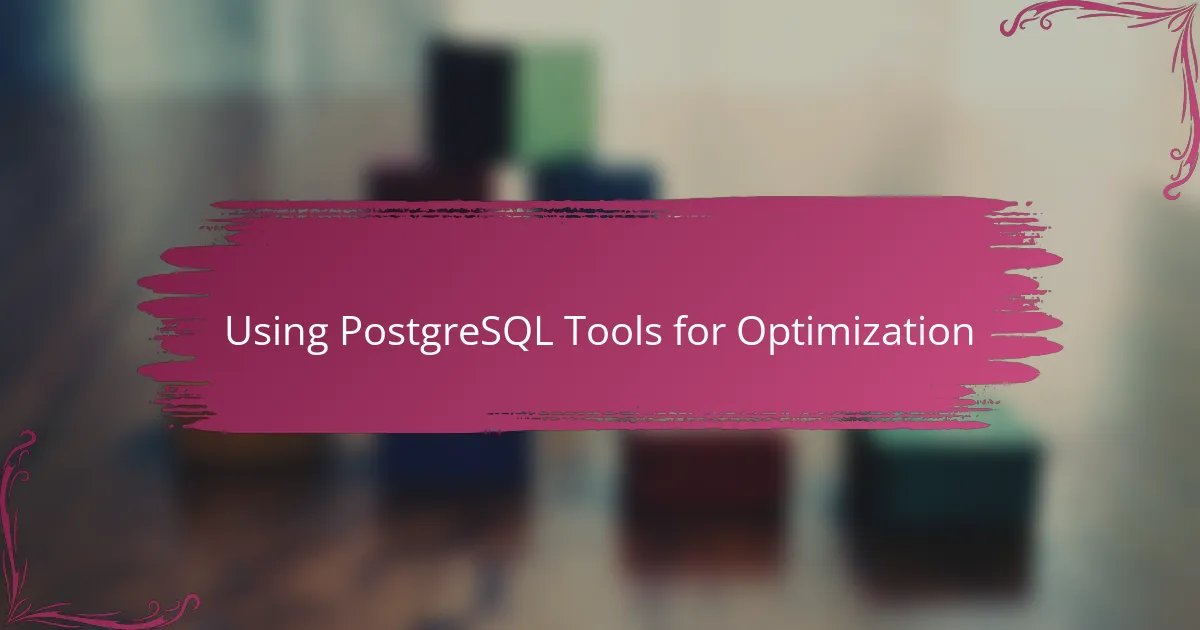Key takeaways
- Understanding the database engine’s behavior and using execution plans is crucial for SQL query optimization.
- Utilizing appropriate indexing, partitioning, and efficient join strategies can significantly improve query performance.
- Regularly monitoring and reevaluating query performance is essential, as data changes can affect execution efficiency.
- Embracing a culture of experimentation and incremental adjustments leads to sustained optimization and improved query speed.

Understanding SQL Query Optimization
When I first started diving into SQL optimization, I quickly realized it’s not just about making queries faster—it’s about understanding how the database engine thinks. Have you ever wondered why some simple-looking queries drag on forever? That’s because the optimizer decides the execution plan, and knowing how it works can unlock serious performance gains.
One thing that struck me was how even small changes in the query structure can have huge impacts. Early on, I would write joins or filters without considering the underlying indexes or data distribution, and the database would struggle. Once I learned to read execution plans and interpret cost estimates, it felt like I’d been handed the manual for the engine’s brain.
Optimizing queries in PostgreSQL isn’t a one-time task; it’s more like a conversation with the database. I found myself constantly tweaking and testing, asking: “Is this the most efficient way?” The process can be challenging, but it’s rewarding when you see a query go from minutes to milliseconds.

Overview of PostgreSQL Performance Features
PostgreSQL comes packed with performance features that, once you get to know them, feel like a secret toolkit. I remember the first time I experimented with its powerful indexing options—like B-tree or GIN indexes—and how drastically they changed the speed of my searches. It made me realize how much the right index can transform query execution.
Another feature that caught my attention was partitioning. At first, the concept seemed a bit daunting, but when I applied it to large datasets, I saw query times drop significantly. Have you ever faced that frustration of waiting forever for a report to load? Partitioning helped me break down that wall.
Then there’s the query planner and its cost-based decisions, which can feel like a mysterious black box. But once I started using tools like EXPLAIN ANALYZE, I gained insight into the planner’s reasoning. It’s like having a conversation again—except now, the database is telling me exactly where it’s slowing down and why. This insight was a game-changer in my optimization journey.

Common SQL Query Bottlenecks
One common bottleneck I ran into was missing or inefficient indexes. It’s surprising how often a full table scan can sneak into your query plan just because an index wasn’t there or wasn’t used correctly. I remember spending hours chasing slow queries only to realize a well-placed index could have cut the time drastically.
Another tricky culprit was complex JOIN operations. I often wrote queries joining multiple large tables without thinking about join order or types, and the result was painfully slow execution. Have you ever waited too long for a report that just kept joining tables endlessly? Tweaking join strategies made me appreciate how much control you really have over query performance.
Finally, filtering on non-indexed columns or using functions on columns in WHERE clauses often trips up the optimizer. At one point, I kept applying functions in my filters out of habit, only to see performance tank because indexes became useless. It taught me to rethink how I write conditions and sometimes rewrite queries for the optimizer’s sake.

Techniques for Writing Efficient Queries
Writing efficient SQL queries often starts with being intentional about selecting the right columns instead of using SELECT *. Early in my experience, I would grab all columns just for convenience, only to face sluggish responses. Narrowing down the result set not only reduces data transferred but also helps PostgreSQL focus its execution strategy better.
Another technique that changed my approach was leveraging WHERE clauses to filter as early as possible. I used to write broad queries and then apply filters in application code, which felt intuitive but slowed everything down. Pushing conditions into the query itself made PostgreSQL trim unnecessary rows sooner, and that immediately sped things up.
I also learned the value of explicit JOIN conditions and understanding join types. It was eye-opening to see how rewriting a query from a LEFT JOIN to an INNER JOIN, when logically possible, slashed execution time. I found myself constantly asking, “Am I joining only what I truly need?” It’s a bit like cleaning out your closet—getting rid of the excess makes everything lighter and easier to manage.

Using PostgreSQL Tools for Optimization
When I first started using PostgreSQL’s built-in tools for optimization, the EXPLAIN and EXPLAIN ANALYZE commands became my best friends. Have you ever felt lost trying to understand why a query drags on? These tools gave me a clear breakdown of the query execution plan, showing exactly where time and resources were spent. It was like switching on a spotlight in a dark room.
Another tool that completely changed how I approached query tuning was pgstatstatements. This extension tracks query performance over time, which helped me identify consistently slow queries instead of chasing occasional hiccups. Knowing which queries were the real culprits allowed me to prioritize my efforts and save hours of guesswork.
I also found the auto-vacuum and statistics collector indispensable in ensuring PostgreSQL’s optimizer had up-to-date information. Early on, I overlooked how stale statistics could mislead the planner into bad decisions, and simply running ANALYZE or tuning autovacuum settings made a huge difference. Have you ever thought about how often your database is keeping itself informed? Turns out, that background work is key to keeping your queries sharp.

Case Study of Personal Query Improvements
I remember one particular query that was dragging on for nearly five minutes—an eternity when you’re waiting on data. After digging into the execution plan, I spotted a missing index that was forcing a full table scan. Adding that index trimmed the runtime down to just a few seconds, and I couldn’t help but feel a rush of satisfaction. Have you ever felt that thrill when a stubborn query finally yields to your tweaks?
Another memorable improvement came when I restructured a convoluted join between three large tables. At first, the query planner was clearly overwhelmed, and the performance was abysmal. By changing the join order and switching some LEFT JOINs to INNER JOINs, I saw a dramatic drop in execution time. It was like solving a puzzle, and that hands-on experience taught me how flexible and powerful thoughtful query design can be.
Sometimes the smallest change made the biggest difference. For instance, rewriting a WHERE clause to avoid applying functions on indexed columns instantly got the optimizer back on track. I joked with myself that I’d fallen into a “function trap,” and realized that paying attention to these details makes optimization less mysterious and way more satisfying. Have you ever caught yourself making a tiny oversight that snowballed into big delays? I certainly have, and fixing those moments became my favorite part of the process.

Best Practices for Ongoing Query Tuning
One thing I’ve learned is that ongoing query tuning requires patience and consistency. Have you ever noticed how a query that performed well last month suddenly starts lagging? That often signals changes in data volume or distribution, reminding me to revisit execution plans regularly instead of assuming “if it’s fast now, it’ll stay fast.” It’s a bit like tending a garden—you can’t just plant and forget.
I also found that setting up routine monitoring helps me catch performance dips early. Using tools like pgstatstatements to track query times over weeks revealed patterns I didn’t expect, such as nightly batch jobs causing temporary slowdowns. This ongoing visibility became my safety net; without it, I’d be guessing instead of knowing where to focus my tuning efforts.
Finally, I try to embrace experimentation as a continuous habit rather than a one-off fix. Sometimes changing a join order or tweaking an index feels small, but seeing those little wins add up over time is incredibly motivating. Have you ever felt that excitement after a simple tweak shaved seconds off a query? That feeling kept me coming back, always curious to see if I could squeeze out even more speed.